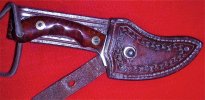I'm always amused when folks point to the work of pioneers like Hibben and Loveless and Moran as "proof" that a certain steel from 40 or 60 years ago is "still good enough". That completely misses the point of
why those men were true pioneers! Those cats were often scoffed at, even ridiculed in their day for seeking out new alloys and techniques. Loveless in particular walked away from 440C in the 70's and continued to work on and with newer alloys nearly until his death. Where would we be today if they hadn't done their research and experimentation, and had simply gone on following the status quo?
If there are suppliers that are not manufacturing it properly, that is a problem with quality control, and has nothing to do with the basic recipe for the steel.
Correct. The chemistry behind 440C is sound, and yes, it most certainly
was considered a "hot new super steel" several decades ago. If a person likes big clumps of carbides, that's fine. When a maker like Laurence has sourced good quality steel and employs optimum HT, it will probably surpass any reasonable person's needs. On the other hand there are still some makers and obviously manus who merely shop around for the cheapest price and use the first HT "recipe" they stumble across... we know where that leads...
Unfortunately, numbers on a datasheet don't mean a whole lot unless you actually know and trust the mill... and the rolling plant, the maker and the heat-treater.
On the other hand, finding a "bad" piece of a more recent particle metallurgy steel is
extremely rare - in fact I don't even know of any quality complaints in the last ten years or so about "powder" steels coming out of Crucible, B/U, Latrobe etc - and they're cleaner, finer-grained, more homogenous alloys with improved chemistry to begin with.
That's the whole point.
Contrary to widespread internet babbling, steel mills don't spend millions on developing this stuff just for fun or to be the "new flavor of the month". There are
specific and important reasons behind the improvements in stainless/tool steels in the last couple decades.
Whether or not most people would ever really notice or care about those improvements in a knife blade - especially a mass-produced one - is a whole different question. But my clients do care, and so do I.



